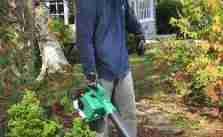Some links on this page are monetized by affiliate programs – see disclosure for details.
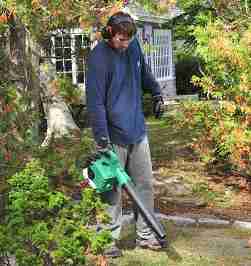 Ever since the first landscaper thought to strap a powerful fan to his back to clean up fallen debris, leaf blowers have been an integral part of lawn and garden maintenance. Today’s modern leaf blowers create powerful blasts of air that can quickly and efficiently tidy and clean any lawn, garden or green space. Using advanced technology, today’s leaf blowers are boosted by powerful motors that take advantage of high-tech engineering to render the blower lightweight but very productive when dispatching leaves and other organic debris.
Ever since the first landscaper thought to strap a powerful fan to his back to clean up fallen debris, leaf blowers have been an integral part of lawn and garden maintenance. Today’s modern leaf blowers create powerful blasts of air that can quickly and efficiently tidy and clean any lawn, garden or green space. Using advanced technology, today’s leaf blowers are boosted by powerful motors that take advantage of high-tech engineering to render the blower lightweight but very productive when dispatching leaves and other organic debris.
With so many leaf blowers on the market today, homeowners and landscapers can take advantage of a wide range of styles, colors and functions. Some smaller lawns and gardens require only a simple blower to make quick weekly tidy-up chores a cinch. Other larger landscaping projects need more powerful blowers with advanced attachments that can work to grind and mulch lawn debris while you work. With a weight and airflow speed capability to suit almost any budget, lawn blowers are becoming the preferred tool of choice by homeowners, property managers and landscapers wanting to keep their house, business and property looking orderly and well-kept.
What are the different types of Leaf Blowers?
Contents
Today’s advanced leaf blowers come in a wide variety of different models, some high-powered blowers for larger and more difficult jobs, and some lower-powered models for smaller lawns and gardens. Some of today’s leaf blowers use electricity, powered by an ordinary extension cord from the house, giving homeowners and landscapers a quieter, easier way to blow leaves and other lawn debris. Other models use powerful two-stroke engines to blast through wet mulch and leaves far from houses and plug-in points.
Some leaf blowers feature have additional handy features, such as a vacuuming or mulching option. While some homeowners prefer the traditional approach of “sweeping” leaves and other lawn debris in front of them by blowing air, others prefer the vacuum option, using the machine to suck up leaves. Mulching options give homeowners and landscapers the environmentally-friendly option of returning organic matter to the soil, improving the health of your garden or lawn.
What are the advantages of owning a Leaf Blower?
In many instances, leaf blowers function as high-powered rakes. When trees drop their leaves and other plants discard organic material, your lawns, yards, footpaths, flower beds, gardens or other green spaces can get quickly covered over. By using a leaf blower, you can direct high-powered jets of air at the ground, pushing fallen leaves and other lawn debris ahead until it can be formed into neat piles and collected or disposed of later.
Today’s leaf blowers are designed to be effective yet lightweight, giving homeowners and landscapers the option of remaining standing, not forced to bend over and torque the back continuously such as with traditional raking. Seniors, teenagers, and anyone with reduced strength or mobility can benefit by using a leaf blower to perform regular lawncare maintenance. With a vacuuming or mulching option, lawns and gardens can be made neat and tidy. And by using an electric leaf blower, homeowners will benefit from the low noise and zero emission efficiency of a fast clean-up job for their decks, sidewalks and driveways.
Which models are the contenders for the Best Leaf Blower?
The Toro 51585 Power Sweep 7 Amp 2-Speed Electric Blower – This trim model in sleek black from Toro can generate up to 160 miles per hour of air flow with it’s two-speed electric motor. Lightweight and easy to maneuver, the Toro 51585 will make short work of clearing up decks, sidewalks, driveways and small lawns or gardens.
Remington RM125 180 MPH 400 CFM 2-Cycle 25cc Gas Handheld Leaf Blower – This sleek blower uses its powerful 25 cc gas motor to offer exceptional leaf-blowing capabilities. Users can switch between two speeds to gear down from a top airflow speed of 180 miles an hour.
The Hitachi RB24EAP 23.9cc 2-Cycle Gas Powered 170 MPH Handheld Leaf Blower – This trim looking commercial-grade leaf blower uses an advanced two-stroke engine to power through vast swathes of dry or wet leaves, clippings and lawn debris. With a supercharged airflow rate of 441 cubic feet per minute, users can rapidly blast sweep large lawns and exterior property areas.
Considerations for Choosing the Best Leaf Blower
- Motor and Blower Speed – Bigger motors can create more powerful airflow, but larger motors may cause more noise or be heavier to carry. Homeowners need to find a leaf blower with the right strength for the jobs at hand.
- Power – Some leaf blowers are powered by traditional two-stroke engines, which deliver top-notch airflow speeds, but require messy maintenance. Other leaf blowers are electric, offering zero emission and lower operating costs at the potential sacrifice of mobility and power.
- Additional Features – Some leaf blowers have reversible engines, allowing homeowners to quickly vacuum up fallen debris and leaves. Other blowers including a mulching option to return valuable organic material to the soil.
- Weight – As all leaf blowers are portable and meant to be carried, the overall weight of the unit is extremely important. Not every homeowner is willing or able to handle heavier leaf blowers.
Conclusion: Our Leaf Blower Reviews Are In
The Toro 51585 Power Sweep 7 Amp 2-Speed Electric Blower – Best Low-Cost Leaf Blower
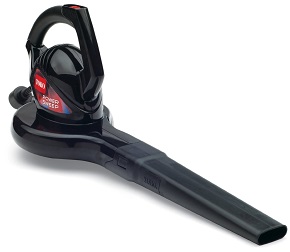 For a low-end leaf blower, the Toro 51585 Power Sweep looks amazingly sleek and modern with its all-black design and elegantly contoured wand. By running an extension cord from a back patio or porch, the Power Sweep can be used to make tidying up decks, sidewalks and driveways after a storm quick and easy.
For a low-end leaf blower, the Toro 51585 Power Sweep looks amazingly sleek and modern with its all-black design and elegantly contoured wand. By running an extension cord from a back patio or porch, the Power Sweep can be used to make tidying up decks, sidewalks and driveways after a storm quick and easy.
With two-speed air control, even a beginner user of leaf blowers will have no problem making short work of leaf and lawn debris clean-up jobs.
Pros:
- The Toro Power Sweep is one of the quietest leaf blowers on the market, which is great for people living in close communities
- Because it’s so light and simple to use, it really is the perfect tool to have around the house for blasting leaves and debris off your property after a storm
- By using electricity, emissions are zero and operating costs are extremely low
- Some people even use the Power Sweep for large indoor jobs such as cleaning up ballrooms, conference areas and meeting rooms with ease
Cons:
- Usually doesn’t ship with an extension cord
- As with all electric-powered motorized tools, it’s important to use the right extension cord gauge for your leaf blower
Remington RM125 180 MPH 400 CFM 2-Cycle 25cc Gas Handheld Leaf Blower – Best Leaf Blower for the Money
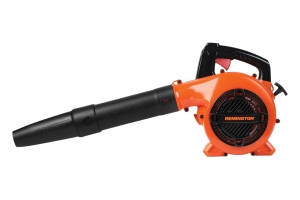 The RM125 is a top of the line gas leaf blower that packs a powerful punch, driving lawn debris and clutter forward with blasts of 180 mph wind. One almost gets the feeling of being a superhero while strapped into the RM125 quickly dispatching and mulching vast swathes of fall leaves and other organic material.
The RM125 is a top of the line gas leaf blower that packs a powerful punch, driving lawn debris and clutter forward with blasts of 180 mph wind. One almost gets the feeling of being a superhero while strapped into the RM125 quickly dispatching and mulching vast swathes of fall leaves and other organic material.
If you’re looking for a top-of-the-line leaf blower at a reasonable price, you need to take a look at this one.
Pros:
- Blows at up to 180 miles per hour
- Easy to start
- Backed by 2-year warranty
Cons:
- Very loud
- Not suited for huge areas
The Hitachi RB24EAP 23.9cc 2-Cycle Gas Powered 170 MPH Handheld Leaf Blower – Best Leaf Blower Overall
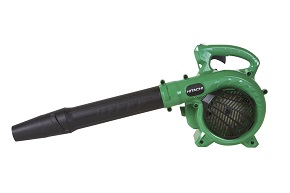 The Hitachi RB24EAP, with its jolly green exterior and advanced lightweight design, offers property owners the ultimate in mobility and power for blowing leaves, clippings and lawn debris. With its adjustable taper nozzle, users can spot blow problem patches of leaves with a withering 170 mile-per-hour air stream.
The Hitachi RB24EAP, with its jolly green exterior and advanced lightweight design, offers property owners the ultimate in mobility and power for blowing leaves, clippings and lawn debris. With its adjustable taper nozzle, users can spot blow problem patches of leaves with a withering 170 mile-per-hour air stream.
Whether used to tidy a lawn after a storm or to plow through big jobs during autumn, the Hitachi RB24EAP is more than up to the job. With its one-hand design, there’s no need for clunky or unsightly backpacks to strap into.
Pros:
- With a low-emission gas motor, homeowners and landscapers don’t have to trip over electric cords while still doing their best to minimize noise and other forms of pollution
- This lightweight and perfectly balanced leaf blower can be handled with ease by even beginners, and will make short work of returning your sidewalks, garden and lawn to a neat and attractive condition
- By careful adjustments to the nozzle and blower power, even beginners can safely dislodge leaves and debris from flower beds, vegetable gardens, and exterior landscaping features
Cons:
- Even though the RB24EAP is a low-emission blower, it still relies on gasoline and messy solvent mixing, which may not be pleasant for some users
- At its highest setting, the tapered jet of air may be so powerful that it can cause damage or injury if not directed prudently
In Conclusion
With so many models to choose from, homeowners and landscapers need to carefully assess their needs before buying a leaf blower. Some leaf blowers are electric, and restrict users to the length and limitations of a long extension cord. Others are gas powered, offering greater mobility and power at the cost of some emissions. Some leaf blowers are smaller and more nimble, great for those quick tidying-up jobs on sidewalks and decks after a rainstorm. Other leaf blowers are powerful jet engines, laying waste to a full coverage of leaves from trees in the autumn.
After careful consideration, the Hitachi RB24EAP offers the best balance of convenience, power and versatility. By using an ingenious tapered nozzle system, homeowners, property managers and landscapers can maximize the output of the low-emission 23.99 cc motor to make quick work of even larger jobs. With its ergonomic sliding control, homeowners can use the Hitachi RB24EAP to gently finesse leaves and lawn debris from flower beds and other finer landscaping features. Neatly balanced to be carried and operated with ease using just one hand, this blower is perfect for anyone who regularly needs to sweep leaves, clippings and lawn debris from their property.
